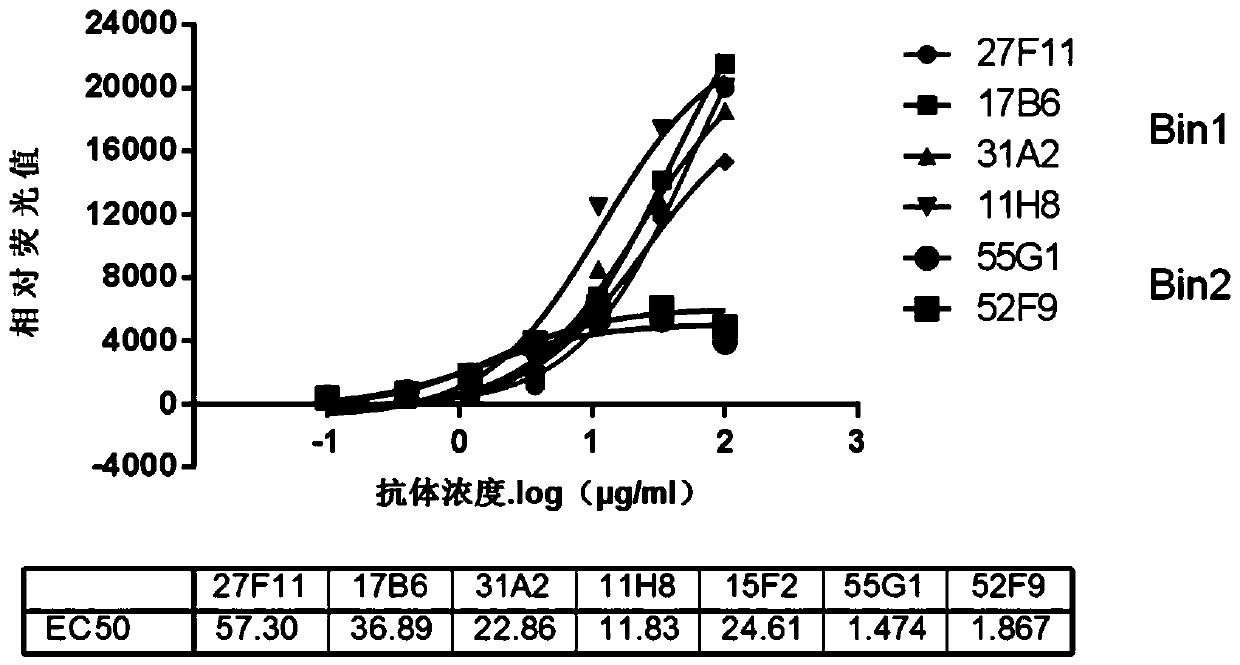Chimeric antigen receptor and application thereof
A chimeric antigen receptor, antigen recognition technology, applied in the direction of antibody medical components, hybrid peptides, receptors/cell surface antigens/cell surface determinants, etc., to improve the duration, enhance the ability of immune monitoring, complete remission period prolonged effect
- Summary
- Abstract
- Description
- Claims
- Application Information
AI Technical Summary
Problems solved by technology
Method used
Image
Examples
Embodiment 1
[0069] Preparation and identification of embodiment 1 hCD19 protein
[0070] Prepare Hcd19 protein according to the following steps, specifically as follows:
[0071] hCD19-fc: Human CD19 recombinant protein (Accession #AAH06338) was expressed in HEK293 cells. The human CD19 gene coding region Pro20-Lys291 sequence (Fc tag at the C-terminus) was selected for transfection. The purified protein was identified by SDS-PAGE gel.
[0072] hCD19-his: Human CD19 recombinant protein (Accession#P15391-1) expressed in HEK293 cells. The human CD19 gene coding region Pro20-Lys291 sequence (His tag used at the C-terminal) was selected for transfection. The purified protein was identified by SDS-PAGE gel.
Embodiment 2
[0073] Example 2 Antibody Preparation
[0074] (I) Antigen Conjugation and Immunization
[0075] (1) Immunoconjugate the hCD19-Fc recombinant protein with various MabSpace immunoenhancing peptides, and complete the control of the conjugated protein by SDS-PAGE gel detection;
[0076] (2) The above conjugated hCD19-Fc protein was emulsified by adding Freund's complete adjuvant (Pierce, Cat#77140) at a ratio of 1:1, and then injected subcutaneously and intraperitoneally into H2L2 mice for immunization. H2L2 mice, produced by HarbourBioMed, carry genes for human variable regions and rat constant regions, and do not contain endogenous mouse antibody genes. Additional immunizations were performed with CpG (cytosine-phosphoryl-guanine) and alum to preserve the native structure of the protein. After the first immunization, and after the immunization (at least once every 2 weeks), the mouse serum was obtained, and the anti-hCD19 titer in the antiserum was analyzed by ELISA method....
Embodiment 3
[0081] Example 3 Positive hybridoma cell subcloning acquisition and small-scale antibody production
[0082] (I) Positive hybridoma cell subcloning
[0083] (1) Carry out gradient dilution of ELISA-positive hybridoma cells on a 96-well plate, and select cells with ideal affinity and blocking activity; after 7 days of culture, cell clones are formed, and the supernatant is collected. 2 for further screening;
[0084] (2) Select the clone with the highest antigen affinity based on the screening results, and expand and culture it in the hybridoma growth medium. After 7 days, the antigen-binding ability of the hybridoma cell culture supernatant after screening was detected again; the subcloning screening test was performed at least twice, until at least 90 wells (96-well plate);
[0085] (3) When more than 90 wells showed positive binding signals, two clones with the highest antigen-binding activity were identified and transferred to 24-well plate culture medium and allowed to...
PUM
 Login to View More
Login to View More Abstract
Description
Claims
Application Information
 Login to View More
Login to View More - R&D
- Intellectual Property
- Life Sciences
- Materials
- Tech Scout
- Unparalleled Data Quality
- Higher Quality Content
- 60% Fewer Hallucinations
Browse by: Latest US Patents, China's latest patents, Technical Efficacy Thesaurus, Application Domain, Technology Topic, Popular Technical Reports.
© 2025 PatSnap. All rights reserved.Legal|Privacy policy|Modern Slavery Act Transparency Statement|Sitemap|About US| Contact US: help@patsnap.com



